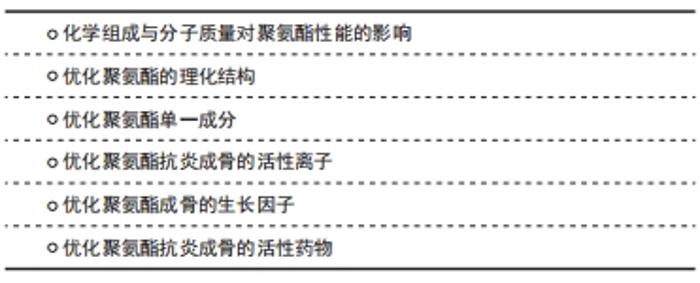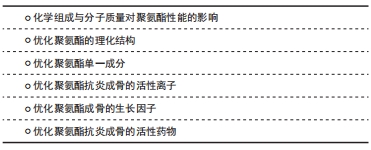Chinese Journal of Tissue Engineering Research ›› 2022, Vol. 26 ›› Issue (21): 3429-3434.doi: 10.12307/2022.655
Previous Articles Next Articles
Application of polyurethane materials in the repair of osteoporotic bone defects
Wang Lu, Li Limei, Li Qing, Yang Hongcai, Lan Xiaoqian, Hu Yingrui
- Center for Science and Technology Achievement Incubation, Kunming Medical University, Kunming 650500, Yunnan Province, China
-
Received:2021-03-23Revised:2021-03-24Accepted:2021-05-30Online:2022-07-28Published:2022-01-28 -
Contact:Li Limei, Associate professor, Center for Science and Technology Achievement Incubation, Kunming Medical University, Kunming 650500, Yunnan Province, China -
About author:Wang Lu, Master candidate, Center for Science and Technology Achievement Incubation, Kunming Medical University, Kunming 650500, Yunnan Province, China
CLC Number:
Cite this article
Wang Lu, Li Limei, Li Qing, Yang Hongcai, Lan Xiaoqian, Hu Yingrui. Application of polyurethane materials in the repair of osteoporotic bone defects[J]. Chinese Journal of Tissue Engineering Research, 2022, 26(21): 3429-3434.
share this article
Add to citation manager EndNote|Reference Manager|ProCite|BibTeX|RefWorks

2.1 骨质疏松性骨缺损治疗面临的挑战 随着人类寿命的不断延长,社会老年化也随之到来,老年化所带来的骨质疏松已成为人类最重要的健康问题之一,已跃居多发常见病的第6位,致使治疗骨质疏松性骨缺损面临极大的挑战。 传统的骨替代材料和抗骨质疏松药物是目前治疗骨质疏松性骨缺损的主要方法,但存在诸多限制。在骨质疏松情况下,低骨量严重影响宿主骨与植入物的结合,而且在预后植入材料处发生骨折的风险极高,显著增加了治疗难度。 通常地,骨质疏松骨缺损的修复需要配合口服药物,以抑制骨质疏松进程。临床上,口服双膦酸盐、阿仑膦酸盐、利塞膦酸盐和伊班膦酸盐都可以有效治疗骨质疏松,但是在依从性问题和胃肠道耐受性方面降低了此类药物的有效性[4]。此外,一般的钙剂和阿托伐联合用药等可通过血液循环进行药物的运送和吸收,以到达治疗病灶[5],但在世界许多地区,一些骨质疏松患者并不能依靠药物取得显著治疗效果,缺乏临床普遍性。唑来膦酸是治疗骨质疏松强效药,但仅仅是髋部骨折后的首选药物[6]。阿帕拉肽不但可以降低椎体或者一些非椎体骨折的风险,还可以显著增加髋关节、股骨颈和腰椎的骨密度。与目前临床上所流通的促合成代谢药物特立帕肽相比,虽然两者的共同作用都可以促进绝经后骨质疏松症骨形成和抑制骨吸收,但是阿巴洛肽可以更好地增加骨矿物密度,然而仅限制应用于绝经后妇女的骨质疏松治疗[7]。 因此,迫切需要开发一类新型修复材料,解决口服药物的吸收率低、靶向作用不明显、胃肠道耐受性等不良反应的治疗方法,更有效改善骨量和骨质量,以实现骨质疏松性骨缺损的再生重建和预后。用于治疗这类骨缺损的生物医用材料种类繁多,其中骨水泥在临床上被广泛应用于骨质疏松骨缺损及其他各种骨缺损的治疗,但是其不可降解性和较差的生物相容性会导致预后不良及炎症等其他并发症;生物医用陶瓷也是一类常用于治疗骨缺损的医用材料,但是它同骨水泥有着同样的诟病,无良好的生物可降解性和相容性,且存在一定的脆性。近年来,可降解生物材料镁合金在临床上成为研究热点,其具有优异的力学性能、良好的生物相容性和可降解性;然而,镁合金材料存在不可控制的降解速度和不可意料的腐蚀速度,因此未能被广泛推崇,有待继续研究和开发[8]。聚氨酯具有多功能活性位点,是骨修复支架的首选材料[9];根据其特有的化学组成和广泛可调的分子质量等特性改善其物理结构和结合多种生物活性物质,不仅可以提供力学支撑强度,增强与宿主骨的结合能力,还能调控其骨诱导性,介导相关的细胞黏附分化,同时改善骨质疏松骨微环境,加速骨骼愈合。 2.2 聚氨酯骨修复材料的应用 "


2.2.1 化学组成与分子质量对聚氨酯性能的影响 聚氨酯主要由异氰酸酯和具活性功能团的聚醚和聚酯多元醇反应生成,其中根据多元醇链的长短不同可以得到不同降解速度的聚氨酯,且聚酯型降解速率高于聚醚型,以用于治疗骨质疏松所引起的不同程度的骨质缺损。通过改变聚氨酯软(多元醇)硬(异氰酸酯和扩链剂)段配比从而得到不同性质的聚氨酯,应用于医学的不同方面[10],比如应用于人造心脏辅助装置、假肢、软骨和骨支架等。另外,随着聚合物分子链长度增加,分子质量不断增大,聚氨酯的微相分离程度增加,由此导致材料硬段的重构,致使聚氨酯出现应力滞后现象,影响与骨的生物相容性,进而阻碍新骨的生成。因此,根据以上聚氨酯材料特点可以对其进行改性,赋予聚氨酯更多的功能和应用范围。为了应对骨质疏松骨缺损修复的挑战,基于聚氨酯的特性,将通过优化聚氨酯的理化结构、材料组成、加载活性离子、生长因子、药物进一步优化聚氨酯成骨性能来进行逐一综述。 2.2.2 优化聚氨酯的理化结构 作为骨组织工程中物质和结构基础的多孔支架,极大地影响着细胞生长及组织重建。一种多孔生物材料除了足够的机械强度还需要具备较高的孔隙率和贯通性,以保证流体扩散,氧气、营养物质和代谢废物的运输及促进细胞、组织向支架内部连续生长。 YANG等[11]采用气体发泡法制备了大孔贯通小孔的含40%羟基磷灰石的聚氨酯海绵状支架,发现该多孔材料不仅能促进细胞的黏附和生长,还有助于增强间充质干细胞的体外增殖和成骨分化能力。在此制备基础上进一步优化聚氨酯的软硬段结构,改良支架孔径的结构,有助于提高促成骨的能力。已有大量实验结论证明,聚氨酯的三维复合结构具有一定的成骨性能,还有一部分学者在探讨如果将聚氨酯改造制备为三维复合结构,能否提高支架的成骨、矿化的性能。 LI等[12]构建了具有分子-纳米-微米-宏观等多层级结构的纳米复合材料,与自然骨的力学性能相似,成功地促进了骨再生和骨/支架的界面整合。优化聚氨酯的方法并未止步于此,通过材料的取向结构可以进一步增强材料特性。 有研究报道称具有取向贯通多孔结构的“莲藕状”支架孔隙率达(77.2±4.1)%,贯通性更好,能够支持骨髓间充质干细胞的黏附、生长、增殖,并且利于应力转移并与主体骨整合、细胞和组织向支架内部渗透长入[13]。 材料表面的拓扑结构同样影响着生物材料的理化特性和功能。AMOROSO等[14]通过设计一种具有表面拓扑结构和化学修饰协同作用的聚氨酯支架,显著增加了生物材料的骨分化活性和抑菌作用,并证实了纳米拓扑结构具有人体仿生学意义,有利于细胞的迁移、交流及细胞所需营养和产生废物的转运。 常规的聚氨酯支架具有固定的形貌结构和大小,一般用于规整的缺损部位,对于不规则的骨质疏松性骨缺损,需要针对缺损部位原位注射成型。有研究者通过调控原料配方制备了可注射性纳米羟基磷灰石/聚氨酯材料,纳米羟基磷灰石的加入不但加强了聚氨酯的力学特性、缩短了固化时间,而且更利于细胞生长,其与松质骨有着相匹配的力学强度和临床可用的固化时间,注射型材料有望解决更多骨质疏松性骨缺损的问题[14]。 2.2.3 优化聚氨酯单一成分 单一组分的骨修复材料在一定程度上限制了骨愈合的疗效,为了满足植入体的力学性能匹配性、亲疏水性、生物活性等需求,将两种及以上的成分组合在一起,构建集多种功能于一体的复合材料,无疑能加速骨质疏松骨缺损的治疗进展。大量的研究工作集中在以弹性、可生物降解的聚氨酯为有机物质,生物活性无机填料如羟基磷灰石、β-磷酸三钙、生物玻璃等复合材料的开发上。由于聚氨酯链上存在极性基团,与无机成分存在较高的亲和力[15],有机-无机两相的相容性有助于提高材料的力学支撑性能,且无机成分的骨诱导性能进一步促进骨再生。 EIVAZZADEH-KEIHAN等[9]采用聚己内酯和异佛尔酮二异氰酸酯分别作为软硬段,仿生制备聚氨酯骨修复支架,发现通过优化软硬段配比实现了聚氨酯微区分相并形成互穿网络多孔结构,同时负载高含量的纳米羟基磷灰石可介导骨组织再生,修复效果明显。在优化软硬段配比的基础上,有研究将二氧化硅纳米颗粒加入聚氨酯制备成三维复合支架,填入大鼠骨缺损中,结果显示有大量的骨祖细胞生成,促进了骨组织的活化-吸收-形成,呈现出良好的生物相容性、骨传导性和成骨诱导能力[16]。 迄今为止,碳酸钙常被添加到聚合物中用来作为补充钙的辅助剂,具有很强的矿化力。将碳酸钙加入蓖麻油基聚氨酯基体,植入骨缺损处,通过测试活检标本发现成骨细胞标记物的存在,而且无慢性炎症和异物反应,具有良好的生物相容性,显著提高了缺损骨处的骨整合性和骨再生能力[17]。 近些年,生物活性玻璃在骨组织修复工程中被广泛关注和应用,生物活性玻璃不仅可以提高仿生三维复合支架的生物活性,还可以显著增强力学强度,所以有研究者在制备复合聚氨酯材料时,将谷氨酰胺基嵌段聚氨酯与活性玻璃纳米颗粒相结合制备了具有良好力学性能的复合材料,活性玻璃纳米颗粒的脆性被谷氨酰胺基嵌段聚氨酯的生物相容性相中和,达到“1+1>2”的效果,使Runx2基因表达显著上调,从而实现促成骨[18]。 目前,有研究者以聚乙二醇和异佛尔酮二异氰酸酯为原料,以胱氨酸二甲酯为交联剂,制备了甘油乙氧基聚脲,用于骨组织修复,该材料在骨组织修复中也具有良好的临床疗效[9]。 菜籽蛋白是营养价值较高的完全蛋白之一,几乎不存在限制氨基酸,具有良好的吸水性、溶解性等。植物油基超支化聚氨酯目前还可与菜籽蛋白功能化的多壁碳纳米管混合,制备出聚氨酯纳米复合材料。菜籽蛋白有助于提高多壁碳纳米管的生物活性,体内外实验表明,相比于其他仿生多壁碳纳米管,生物功能化的聚氨酯纳米复合材料对骨缺损修复的效果更加显著[19]。中国的蛋白资源较为缺乏,如果将大量低成本的菜籽蛋白转化为可利用资源,将具有重要的社会和经济意义。 对于现有的一些医用支架,联合促成骨特性和抗炎作用才能更好地辅助新骨质生成。因此,可以通过在嵌段聚氨酯上添加二维单晶铋掺杂的纳米羟基磷灰石制备出引导骨再生支架,不仅具有促成骨的作用,而且还能有效抗感染[20]。 面对一些特异性缺损部位,有研究利用二甲双胍作为扩链剂,已将聚己内酯二醇与六亚甲基二异氰酸酯整合到聚氨酯大分子结构中,混合制备了新型生物可降解弹性骨再生膜,并证明该薄膜具有良好的生物可降解性和成骨性能[21]。 β-环糊精具有促溶性,常被添加到高分子聚合物中。有实验将β-环糊精与六亚甲基二异氰酸酯和羟基磷灰石原位聚合成功制备了新型的聚氨酯复合支架,并呈现出良好的生物相容性和促成骨作用[22]。 除了在聚合物中添加促溶剂可以增加机体与材料之间的生物活化联系之外,还有研究团队将明胶加入羟基磷灰石以增强生物活性剂作用,用来提高聚氨酯支架的物理特性,增强了促磷酸钙沉积性能和骨修复能力[23]。 2.2.4 优化聚氨酯抗炎成骨的活性离子 天然骨除了钙磷复合成分外,还含锌(Zn)、锶(Sr)、镁(Mg)离子等微量元素。在骨质疏松中,这些特定的离子在调节成骨细胞和破骨细胞的分化平衡、维持骨代谢稳态等方面起着重要作用,是降低人类骨质疏松潜在危险因素的一种有效成分。此外,这一类离子能够减弱炎症反应,通过浓度控释可以调控骨免疫微环境,是新型骨生物材料的重要研发策略[24]。 镁、硅金属具有良好的生物相容性、可降解性和安全性,是理想的骨移植材料,根据其活性启发,研究人员通过添加镁离子或硅离子制备了掺杂活性离子的羟基磷灰石,进一步将磷灰石复合到聚氨酯/聚乳酸电纺材料,提高了复合材料的促成骨效果[25]。 除了镁离子外,锶离子在促进血管和成骨生成及抑制破骨形成方面也有一定的作用,可提高成骨细胞的增殖和分化,抑制破骨细胞的生长。将含锶的羟基磷灰石和β-磷酸三钙两种钙磷材料和聚氨酯复合,结果表明不仅能够提高支架的力学性能和降解性能,还能促进材料的成骨性能[26]。将活性玻璃与锶结合治疗骨质疏松亦取得了一定的治疗效果[27]。 锌离子也是骨代谢过程中不可或缺的重要微量元素之一,具有促进骨形成和矿化的功效,使新的骨质生成,减少破骨细胞的吸收。有研究利用定制的磁控溅射技术在磺化聚醚醚酮生物材料上加入一层锌离子,结果表明,锌包覆磺化聚醚醚酮上的微环境可调节非激活巨噬细胞极化至抗炎表型,并诱导分泌抗炎和成骨细胞因子,从而增强了骨髓基质细胞的成骨分化能力[28]。锌离子替代部分钙离子后,羟基磷灰石等生物材料的骨整合能力和移植体-宿主骨的固定性显著增强[29]。 2.2.5 优化聚氨酯成骨的生长因子 骨质疏松导致骨缺损后需要调控成骨-破骨的动态平衡,加速骨再生速度。近年来,为了提高聚氨酯的成骨诱导能力,生长因子的加入备受青睐,通过细胞生长因子对其表面进行修饰,赋予了生物材料主动调节细胞行为和组织生长的功能,是提升材料成骨活性的重要手段之一。已有大量研究采用聚氨酯支架控释不同的生长因子,如碱性成纤维生长因子、牛血清白蛋白[30]、血小板源生长因子[31]、转化生长因子β及骨形态蛋白2[32],以刺激成骨细胞分化,促进骨形成。 LI等[33]首次研究了聚乙二醇、己内酯/乙交酯三聚体的聚氨酯体系包裹重组人骨形态蛋白2,发现该材料仅在2周后支持新骨的生长。 KIM等[34]也对重组人骨形态发生蛋白的持续释放进行了研究,同向加温的聚乙二醇基聚氨酯支架能够支持重组人骨形态蛋白2释放达21 d,相对于外源性的重组人骨形态蛋白2组(阳性对照),该材料促进了人间充质干细胞的显著矿化,具有较高的生物活性。 人转化生长因子β1、人转化生长因子β3纤维蛋白同样具有一定的生物活性,有研究将骨髓基质干细胞接种于添加纤维蛋白的聚氨酯支架,培养35 d后各项检测指标表明有助于成骨[35]。 血管内皮生长因子能够促进成骨细胞的增殖、分化,并提高成骨钙素、Ⅰ型胶原的生成量。有研究者将含硅的羟基磷灰石制成添加血管内皮生长因子的多孔支架,促使新骨质生成的同时增加了骨小梁厚度[36]。 另外,有相关研究采用气体发泡法制备聚乳酸-羟基乙酸共聚物多孔三维骨诱导支架,利用微球装载生长因子,实验证明该生物材料具有较高的适应性和组织相容性,在骨组织工程中具有很高的应用价值[37]。 2.2.6 优化聚氨酯抗炎成骨的活性药物 聚氨酯的多种可修饰性和加工工艺赋予了其一种很有吸引力的控制药物释放性能,可作为药物载体和传递系统材料。聚氨酯纳米颗粒、涂层或具不同孔隙率和孔径尺寸的支架,原料的不同成分和亲水特性,软硬段的类型和比例,结晶度和交联度等性质,均能有效控制药物释放的速度和数量[38]。此外,改善聚氨酯的交联度使其具有水凝胶的性质,可以吸收大量的水而不溶解,这是药物载体的一个重要特性[39]。目前,开发局部给药系统以防止植入体内后的感染和炎症,并促进血管化和新骨再生,是倍受关注的问题。 万古霉素是一种糖肽类抗生素,传统上被用作“最后一线药物”用来治疗所有抗生素均无效的严重感染。LI等[40]利用万古霉素强大而普遍的抗菌抗炎特性,以聚乙二醇、赖氨酸二氯氢酸酯为原料,Tegoamin 33为催化剂,水为发泡剂制备聚氨酯支架,并缓释万古霉素以防止术后感染,该聚氨酯支架植入大鼠感染节段性缺损,与未处理的对照组相比,感染明显减少、新骨质生成量显著增加。 吲哚美辛与万古霉素一样被应用于骨组织工程,其中的吲哚美辛为非类固醇抗炎药,具有抗炎、解热及镇痛作用。骨支架加载药物之后,药物的缓释速度同支架本身的降解速度同样重要。GENTILE等[41]基于涂有明胶的陶瓷支架,将载有药物吲哚美辛的聚氨酯纳米颗粒加入到支架中,不仅有效增加了支架的压缩模量,1周内可持续释放药物(载药量的65%-70%),且不影响 MG-63细胞的活力和碱性磷酸酶活性。 所构建的系统不仅要解决聚氨酯的药物缓释速度,而且还要有抗侵扰作用,才能进一步提高抗炎和促成骨功能。为此,KOLMAS等[42]探寻一种载药体系来抑制骨肿瘤的生长和其他细胞的侵袭,所构建的聚氨酯-羟基磷灰石复合物能够延长双膦酸盐的释放,8周后释放量从20%到80%,赋予了药物控制释放的许多可能性。同样,GRZESIAK等[43]将白藜芦醇加载到聚氨酯/聚乳酸支架,结果发现缓释体系具有促细胞增殖、抗凋亡和氧化应激及促成骨作用,也发挥着排异作用 。 左氧氟沙星对革兰阴性菌有很强的抵抗作用,是很普遍的强效抗炎药。有研究者将5 mg左氧氟沙星与二氧化硅微球/纳米羟基磷灰石/聚氨酯成功合成了一种新型抗生素复合支架,实验结果表明该支架治疗效果更佳[44]。 银离子抗炎的特性一直从古延续至今,将3%磷酸银颗粒融入到多孔纳米羟基磷灰石/聚氨酯复合支架中,有较强的抗菌性能和良好的生物相容性,可以很大程度上修复骨缺损并治疗相关感染[45]。 他汀类药物是抑制3-羟基-3-甲基戊二酰辅酶A还原酶和降低血清胆固醇的天然产物化合物,将洛伐他汀加载到可生物降解的弹性体聚氨酯支架中,植入受损的骨组织处后洛伐他汀持续释放,并在体内、外持续增加人骨形态蛋白2的表达,进而刺激新骨形成,促进骨再生修复[46]。 淫羊藿苷是中国特有的一种抗骨质疏松中草药之一,与聚氨酯结合后,通过上调成骨基因和BMAL1的表达促进骨髓间充质干细胞的增殖。此外,BMAL1过表达上调成骨基因人骨形态蛋白、RUNX家族转录因子2、碱性磷酸酶的表达,进一步促进骨髓间充质干细胞的增殖和分化[47]。 姜黄素也是被普遍应用的传统促成骨中药,将适当浓度的姜黄素加载到聚氨酯支架,与干细胞共培养后进行检测无细胞毒性,而且通过激活PI3K/AKT/Nrf2信号通路促进成骨分化[48]。 壳聚糖具有活化细胞和抗炎的功能,采用冷冻干燥方法将壳聚糖与水性聚氨酯结合制备成多孔支架,将成骨细胞接种到该支架上,结果表明该支架有助于成骨细胞的黏附和生长[49]。 天麻素是云南特色中草药天麻的一种主要单体成分,具有多羟基官能团,化学结构与葡萄糖类似。从药理作用上看,天麻素具有增强抗氧化物酶活性的作用,能够抗氧化应激、抗细胞凋亡,改善骨微环境的动态平衡;且天麻素可减慢骨吸收进程,阻止细胞向成脂和成破骨方向分化[50]。LIU等[51]将天麻素成功接枝到聚氨酯基体制备了天麻素缓释聚氨酯支架,该支架能有效促进成骨细胞的黏附、分化和矿化,且具有明显的抗炎功效和促进血管生成作用,是一种潜在的骨质疏松骨缺损修复材料。"

| [1] DIMITRIOU R, JONES E, MCGONAGLE D, et al. Bone regeneration: current concepts and future directions. BMC Med. 2011;9:66. [2] LANE NE. Epidemiology, etiology, and diagnosis of osteoporosis. Am J Obstet Gynecol. 2006;194(2 Suppl):S3-S11. [3] 冯照喧.生物基可降解聚氨酯的合成、功能化改性及医学应用研究[D].北京:北京科技大学,2021. [4] TAKEZAWA T. A strategy for the development of tissue engineering scaffolds that regulate cell behavior. Biomaterials. 2003;24(13):2267-2275. [5] ZHOU Z, WANG Y, QIAN Y, et al. Cystine dimethyl ester cross-linked PEG-poly(urethane-urea)/nano-hydroxyapatite composited biomimetic scaffold for bone defect repair. J Biomater Sci Polym Ed. 2020;31(3):407-422. [6] MIRABBASI F, DORKOOSH F, MOGHIMI A, et al. Preparation of Mesalamine Nanoparticles Using a Novel Polyurethane- Chitosan Graft Copolymer. Pharm Nanotechnol. 2017;5(3):230-239. [7] SLEEMAN A, CLEMENTS JN. Abaloparatide: A new pharmacological option for osteoporosis. Am J Health-Systph. 2019;76(3):130-135. [8] 雷宇.可降解生物医用镁合金材料的研究进展[J].有色冶金设计与研究,2019,40(4):5-8. [9] EIVAZZADEH-KEIHAN R, MALEKI A, DE LA GUARDIA M, et al. Carbon based nanomaterials for tissue engineering of bone: Building new bone on small black scaffolds: A review. J Adv Res. 2019;18:185-201. [10] 刘彩兵.可降解聚氨酯共聚物的合成、结构与性能研究[D].成都:四川大学,2007. [11] YANG W, BOTH SK, ZUO Y, et al. Biological evaluation of porous aliphatic polyurethane/hydroxyapatite composite scaffolds for bone tissue engineering. J Biomed Mater Res A. 2015;103(7):2251-2259. [12] LI L, ZUO Y, ZOU Q, et al. Hierarchical Structure and Mechanical Improvement of an n-HA/GCO-PU Composite Scaffold for Bone Regeneration. ACS Appl Mater Interfaces. 2015;7(40):22618-22629. [13] WAHBA MI. Enhancement of the mechanical properties of chitosan. J Biomater Sci Polym Ed. 2020;31(3):350-375. [14] AMOROSO NJ, D’AMORE A, HONG Y, et al. Elastomeric electrospun polyurethane scaffolds: the interrelationship between fabrication conditions, fiber topology, and mechanical properties. Adv Mater. 2011;23(1):106-111. [15] SHAFIEE A, ATALA A. Tissue Engineering: Toward a New Era of Medicine. Annu Rev Med. 2017;68:29-40. [16] NACER RS, POPPI RR, CARVALHO PDE T, et al. Castor oil polyurethane containing silica nanoparticles as filling material of bone defect in rats. Acta Cir Bras. 2012;27(1):56-62. [17] NÓBREGA FS, SELIM MB, ARANA-CHAVEZ VE, et al. Histologic and immunohistochemical evaluation of biocompatibility of castor oil polyurethane polymer with calcium carbonate in equine bone tissue. Am J Vet Res. 2017;78(10):1210-1214. [18] AGUILAR-PÉREZ FJ, VARGAS-CORONADO RF, CERVANTES-UC JM, et al. Preparation and bioactive properties of nano bioactive glass and segmented polyurethane composites. J Biomater Appl. 2016;30(9): 1362-1372. [19] DAS B, CHATTOPADHYAY P, MAJI S, et al. Bio-functionalized MWCNT/hyperbranched polyurethane bionanocomposite for bone regeneration. Biomed Mater. 2015;10(2):025011. [20] SELVAKUMAR M, SRIVASTAVA P, PAWAR HS, et al. On-Demand Guided Bone Regeneration with Microbial Protection of Ornamented SPU Scaffold with Bismuth-Doped Single Crystalline Hydroxyapatite: Augmentation and Cartilage Formation. ACS Appl Mater Interfaces. 2016;8(6):4086-4100. [21] YAGCI BS, ODABAS S, AKSOY EA. Development of metformin chain extended polyurethane elastomers as bone regenerative films. Eur J Pharm Sci. 2019;131:84-92. [22] DU J, GAN S, BIAN Q, et al. Preparation and characterization of porous hydroxyapatite/β-cyclodextrin-based polyurethane composite scaffolds for bone tissue engineering. J Biomater Appl. 2018;33(3):402-409. [23] GIULIANI C. The Flavonoid Quercetin Induces AP-1 Activation in FRTL-5 Thyroid Cells. Antioxidants (Basel). 2019;8(5):112. [24] 陈泽涛,王小双,张琳珺.基于“骨免疫微环境调控”的骨替代材料研发理念[J].口腔疾病防治,2018,26(11):688-698. [25] SZURKOWSKA K, DROBNIEWSKA A, KOLMAS J. Dual Doping of Silicon and Manganese in Hydroxyapatites: Physicochemical Properties and Preliminary Biological Studies. Materials (Basel). 2019;12(16):2566. [26] CHEN Y, LIU Z, JIANG T, et al. Strontium-substituted biphasic calcium phosphate microspheres promoted degradation performance and enhanced bone regeneration. J Biomed Mater Res A. 2020;108(4):895-905. [27] KARGOZAR S, MONTAZERIAN M, FIUME E, et al. Multiple and Promising Applications of Strontium (Sr)-Containing Bioactive Glasses in Bone Tissue Engineering. Front Bioeng Biotechnol. 2019;7:161. [28] LIU W, LI J, CHENG M, et al. Zinc-Modified Sulfonated Polyetheretherketone Surface with Immunomodulatory Function for Guiding Cell Fate and Bone Regeneration. Adv Sci (Weinh). 2018; 5(10):1800749. [29] TAO ZS, ZHOU WS, HE XW, et al. A comparative study of zinc, magnesium, strontium-incorporated hydroxyapatite-coated titanium implants for osseointegration of osteopenic rats. Mater Sci Eng C Mater Biol Appl. 2016;62:226-232. [30] LI B, DAVIDSON JM, GUELCHER SA. The effect of the local delivery of platelet-derived growth factor from reactive two-component polyurethane scaffolds on the healing in rat skin excisional wounds. Biomaterials. 2009;30(20):3486-3494. [31] HAFEMAN AE, LI B, YOSHII T, et al. Injectable biodegradable polyurethane scaffolds with release of platelet-derived growth factor for tissue repair and regeneration. Pharm Res. 2008;25(10):2387-2399. [32] LI Z, KUPCSIK L, YAO SJ, et al. Mechanical load modulates chondrogenesis of human mesenchymal stem cells through the TGF-beta pathway. J Cell Mol Med. 2010;14(6A):1338-1346. [33] LI B, YOSHII T, HAFEMAN AE, et al. The effects of rhBMP-2 released from biodegradable polyurethane/microsphere composite scaffolds on new bone formation in rat femora. Biomaterials. 2009;30(35):6768-6779. [34] KIM J, HOLLINGER JO. Recombinant human bone morphogenetic protein-2 released from polyurethane-based scaffolds promotes early osteogenic differentiation of human mesenchymal stem cells. Biomed Mater. 2012;7(4):045008. [35] FROELICH K, SETIAWAN LE, TECHNAU A, et al. Influence of different growth factors on chondrogenic differentiation of adipose-derived stem cells in polyurethane-fibrin composites. Int J Artif Organs. 2012; 35(12):1047-1060. [36] CASARRUBIOS L, GÓMEZ-CEREZO N, SÁNCHEZ-SALCEDO S, et al. Silicon substituted hydroxyapatite/VEGF scaffolds stimulate bone regeneration in osteoporotic sheep. Acta Biomater. 2020;101:544-553. [37] REYES R, DELGADO A, SOLIS R, et al. Cartilage repair by local delivery of transforming growth factor-β1 or bone morphogenetic protein-2 from a novel, segmented polyurethane/polylactic-co-glycolic bilayered scaffold. J Biomed Mater Res A. 2014;102(4):1110-1120. [38] DA SILVA GR, AYRES E, OREFICE RL, et al. Controlled release of dexamethasone acetate from biodegradable and biocompatible polyurethane and polyurethane nanocomposite. J Drug Target. 2009; 17(5):374-383. [39] PATEL A, MEQUANINT K. Novel physically crosslinked polyurethane-block-poly(vinyl pyrrolidone) hydrogel biomaterials. Macromol Biosci. 2007;7(5):727-737. [40] LI B, BROWN KV, WENKE JC, et al. Sustained release of vancomycin from polyurethane scaffolds inhibits infection of bone wounds in a rat femoral segmental defect model. J Control Release. 2010;145(3):221-230. [41] GENTILE P, BELLUCCI D, SOLA A, et al. Composite scaffolds for controlled drug release: role of the polyurethane nanoparticles on the physical properties and cell behaviour. J Mech Behav Biomed Mater. 2015;44:53-60. [42] KOLMAS J, SOBCZAK M, OLĘDZKA E, et al. Synthesis, characterization and in vitro evaluation of new composite bisphosphonate delivery systems. Int J Mol Sci. 2014;15(9):16831-16847. [43] GRZESIAK J, MARYCZ K, SZAREK D, et al. Polyurethane/polylactide-based biomaterials combined with rat olfactory bulb-derived glial cells and adipose-derived mesenchymal stromal cells for neural regenerative medicine applications. Mater Sci Eng C Mater Biol Appl. 2015;52:163-170. [44] WANG Q, CHEN C, LIU W, et al. Levofloxacin loaded mesoporous silica microspheres/nano-hydroxyapatite/polyurethane composite scaffold for the treatment of chronic osteomyelitis with bone defects. Sci Rep. 2017;7:41808. [45] JIANG J, LI L, LI K, et al. Antibacterial nanohydroxyapatite/polyurethane composite scaffolds with silver phosphate particles for bone regeneration. J Biomater Sci Polym Ed. 2016;27(16):1584-1598. [46] YOSHII T, HAFEMAN AE, NYMAN JS, et al. A sustained release of lovastatin from biodegradable, elastomeric polyurethane scaffolds for enhanced bone regeneration. Tissue Eng Part A. 2010;16(7):2369-2379. [47] HUANG Z, WEI H, WANG X, et al. Icariin promotes osteogenic differentiation of BMSCs by upregulating BMAL1 expression via BMP signaling. Mol Med Rep. 2020;21(3):1590-1596. [48] SHABABDOUST A, EHSANI M, SHOKROLLAHI P, et al. Fabrication of curcumin-loaded electrospun nanofiberous polyurethanes with anti-bacterial activity. Prog Biomater. 2018;7(1):23-33. [49] ZO S, CHOI S, KIM H, et al. Synthesis and Characterization of Carboxymethyl Chitosan Scaffolds Grafted with Waterborne Polyurethane. J Nanosci Nanotechnol. 2020;20(8):5014-5018. [50] LI Q, LI L, YU M, et al. Elastomeric polyurethane porous film functionalized with gastrodin for peripheral nerve regeneration. J Biomed Mater Res A. 2020;108(8):1713-1725. [51] LIU S, ZHOU L, YANG L, et al. Gastrodin alleviates glucocorticoid induced osteoporosis in rats via activating the Nrf2 signaling pathways. Oncotarget. 2018;9(14):11528-11540. [52] 王品品. 新型骨修复用反应性聚氨酯的研究[D].重庆:重庆大学, 2013. [53] 杨明璨,朱楚洪.不同分子量的PEG改性聚氨酯以及表面的血液相容性研究[J].局解手术学杂志,2013,22(3):259-261. |
| [1] | Jiang Huanchang, Zhang Zhaofei, Liang De, Jiang Xiaobing, Yang Xiaodong, Liu Zhixiang. Comparison of advantages between unilateral multidirectional curved and straight vertebroplasty in the treatment of thoracolumbar osteoporotic vertebral compression fracture [J]. Chinese Journal of Tissue Engineering Research, 2022, 26(9): 1407-1411. |
| [2] | Xue Yadong, Zhou Xinshe, Pei Lijia, Meng Fanyu, Li Jian, Wang Jinzi . Reconstruction of Paprosky III type acetabular defect by autogenous iliac bone block combined with titanium plate: providing a strong initial fixation for the prosthesis [J]. Chinese Journal of Tissue Engineering Research, 2022, 26(9): 1424-1428. |
| [3] | Zhu Chan, Han Xuke, Yao Chengjiao, Zhou Qian, Zhang Qiang, Chen Qiu. Human salivary components and osteoporosis/osteopenia [J]. Chinese Journal of Tissue Engineering Research, 2022, 26(9): 1439-1444. |
| [4] | Li Wei, Zhu Hanmin, Wang Xin, Gao Xue, Cui Jing, Liu Yuxin, Huang Shuming. Effect of Zuogui Wan on bone morphogenetic protein 2 signaling pathway in ovariectomized osteoporosis mice [J]. Chinese Journal of Tissue Engineering Research, 2022, 26(8): 1173-1179. |
| [5] | Xiao Hao, Liu Jing, Zhou Jun. Research progress of pulsed electromagnetic field in the treatment of postmenopausal osteoporosis [J]. Chinese Journal of Tissue Engineering Research, 2022, 26(8): 1266-1271. |
| [6] | Tang Wenjing, Wu Siyuan, Yang Chen, Tao Xi. Inflammatory responses in post-stroke depression [J]. Chinese Journal of Tissue Engineering Research, 2022, 26(8): 1278-1285. |
| [7] | Wu Weiyue, Guo Xiaodong, Bao Chongyun. Application of engineered exosomes in bone repair and regeneration [J]. Chinese Journal of Tissue Engineering Research, 2022, 26(7): 1102-1106. |
| [8] | Zhou Hongqin, Wu Dandan, Yang Kun, Liu Qi. Exosomes that deliver specific miRNAs can regulate osteogenesis and promote angiogenesis [J]. Chinese Journal of Tissue Engineering Research, 2022, 26(7): 1107-1112. |
| [9] | Gao Yujin, Peng Shuanglin, Ma Zhichao, Lu Shi, Cao Huayue, Wang Lang, Xiao Jingang. Osteogenic ability of adipose stem cells in diabetic osteoporosis mice [J]. Chinese Journal of Tissue Engineering Research, 2022, 26(7): 999-1004. |
| [10] | Peng Kun. Improvement of the treatment effect of osteoporotic fractures: research status and strategy analysis [J]. Chinese Journal of Tissue Engineering Research, 2022, 26(6): 980-984. |
| [11] | Li Hui, Chen Lianglong. Application and characteristics of bone graft materials in the treatment of spinal tuberculosis [J]. Chinese Journal of Tissue Engineering Research, 2022, 26(4): 626-630. |
| [12] | Ou Liang, Kong Dezhong, Xu Daoqing, Ni Jing, Fu Xingqian, Huang Weichen. Comparative clinical efficacy of polymethyl methacrylate and self-solidifying calcium phosphate cement in vertebroplasty: a meta-analysis [J]. Chinese Journal of Tissue Engineering Research, 2022, 26(4): 649-656. |
| [13] | Shen Song, Xu Bin. Diffuse distribution of bone cement in percutaneous vertebroplasty reduces the incidence of refracture of adjacent vertebral bodies [J]. Chinese Journal of Tissue Engineering Research, 2022, 26(4): 499-503. |
| [14] | Tan Guozhong, Tu Xinran, Guo Liyang, Zhong Jialin, Zhang Yang, Jiang Qianzhou. Biosafety evaluation of three-dimensional printed gelatin/sodium alginate/58S bioactive glass scaffolds for bone defect repair [J]. Chinese Journal of Tissue Engineering Research, 2022, 26(4): 521-527. |
| [15] | Zhong Yuanming, He Bingkun, Wu Zhuotan, Wu Sixian, Wan Tong, Zhong Xifeng. Meta-analysis of efficacy and safety of Jack kyphoplasty for osteoporotic vertebral compression fractures [J]. Chinese Journal of Tissue Engineering Research, 2022, 26(3): 487-492. |
| Viewed | ||||||
|
Full text |
|
|||||
|
Abstract |
|
|||||